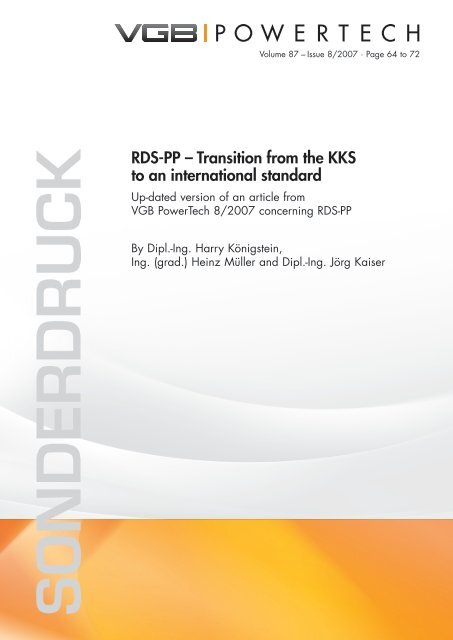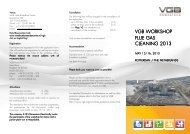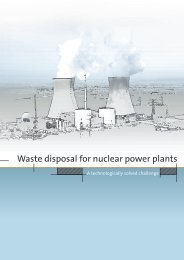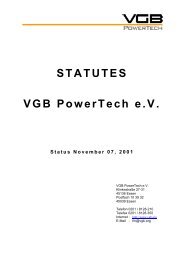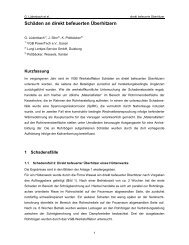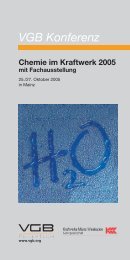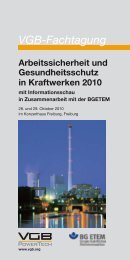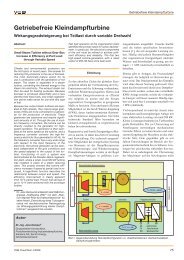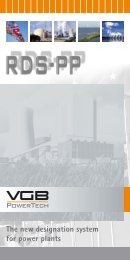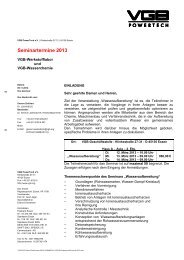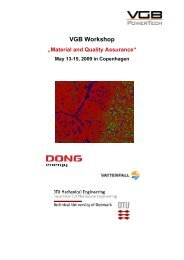Download Einladung_Flyer - VGB PowerTech
Download Einladung_Flyer - VGB PowerTech
Download Einladung_Flyer - VGB PowerTech
You also want an ePaper? Increase the reach of your titles
YUMPU automatically turns print PDFs into web optimized ePapers that Google loves.
Volume 87 – Issue 8/2007 ∙ Page 64 to 72<br />
RDS-PP – Transition from the KKS<br />
to an international standard<br />
Up-dated version of an article from<br />
<strong>VGB</strong> <strong>PowerTech</strong> 8/2007 concerning RDS-PP<br />
By Dipl.-Ing. Harry Königstein,<br />
Ing. (grad.) Heinz Müller and Dipl.-Ing. Jörg Kaiser
RDS-PP – Transition from the KKS<br />
to an international standard<br />
Up-dated version of an article from <strong>VGB</strong> <strong>PowerTech</strong> 8/2007 concerning RDS-PP<br />
Abstract<br />
New and withdrawn standards and the revised<br />
EU Directives relating to reference designation<br />
and plant documentation also have a significant<br />
impact also on the KKS power plants<br />
reference designation system run by <strong>VGB</strong><br />
<strong>PowerTech</strong>.<br />
To gain acceptance on the international markets,<br />
to ensure compliance with valid standards<br />
in conjunction with conformity declarations<br />
and to satisfy safety provisions in plants,<br />
both manufacturers and operators needed to<br />
adopt the KKS to current rules and regulations.<br />
The work was carried out in the <strong>VGB</strong> “Reference<br />
Designation and Plant Documentation”<br />
Working Panel and resulted in a technical<br />
standard for reference designation in power<br />
plants and a key for power plant systems -<br />
the “system key”. Experience and known potentials<br />
for improvement in the use of KKS<br />
complete the adoption and creation of the<br />
KKS replacement system. The new standardized<br />
reference designation system is called<br />
“Reference Designation System for Power<br />
Plants RDS-PP”.<br />
The technical standard is based on the basic<br />
principles of international standards and<br />
takes into account nearly all the KKS structures.<br />
Around 90% of the code letters in the<br />
KKS function key were transferred to the new<br />
system key. KKS aggregate and equipment<br />
key will be replaced in the new reference<br />
designation system by a standard in which<br />
the code letters are standardised globally for<br />
specialist fields and sectors. These code letters<br />
do not unfortunately always match the<br />
KKS-specifications.<br />
There are tools available for comparing RDS-<br />
PP to KKS and for performing the required<br />
conversion from KKS to RDS-PP. These tools<br />
support the transfer of the KKS function key<br />
to the RDS-PP system key and from the aggregate<br />
and equipment key to the code letters<br />
in the international standard.<br />
The article depicts the development of the<br />
new reference designation system from the<br />
point of view of standardisation, describes<br />
the main features, mentions offers of support<br />
by the <strong>VGB</strong> “Reference designation and plant<br />
documentation” working panel and provides<br />
recommendations for future use.<br />
Authors<br />
Dipl.-Ing. Harry Königstein<br />
STEAG Power Saar GmbH,<br />
Saarbrücken/Germany<br />
Ing. (grad.) Heinz Müller<br />
Siemens Power Generation,<br />
Erlangen/Germany<br />
Dipl.-Ing. Jörg Kaiser<br />
<strong>VGB</strong> <strong>PowerTech</strong>, Essen/Germany<br />
General<br />
The KKS Identification System for Power<br />
Plants has been successfully used worldwide<br />
since the early nineteen seventies for the designation<br />
of plants, technical equipment and<br />
components in power plants.<br />
The issuing of international basic standards on<br />
reference designation in the year 1996 and the<br />
quoting of such standards in European directives<br />
and harmonized standards called for an<br />
adjustment of the KKS to such specifications.<br />
The main motivation for this was for the<br />
manufacturers to assert themselves in the<br />
European and worldwide markets by ensuring<br />
conformity with the standards and for the<br />
power plant operators to avail themselves of a<br />
standardized equipment designation basis for<br />
their work.<br />
The basic principles necessary for such adjustment<br />
and certain amendments of the KKS<br />
were developed in the <strong>VGB</strong> Technical Committee<br />
“Reference Designation and Plant<br />
Documentation” jointly by manufacturers<br />
and operators and contributed to the national<br />
and international standardizing activities. The<br />
main objective was to arrive at a sector-specific<br />
standard for power plants. The result is<br />
now available:<br />
In April 2007, the Joint Committee for Reference<br />
Designation Systems (GAKS) at the DIN<br />
published the national standard DIN 6779-10<br />
“Structuring principles for technical products<br />
Electrical<br />
engineering<br />
international<br />
Electrical<br />
engineering<br />
national<br />
Power plant<br />
engineering<br />
national<br />
DIN EN<br />
IEC 750<br />
DIN<br />
40917-2<br />
19227<br />
All disciplines<br />
international<br />
All disciplines<br />
international<br />
DIN EN<br />
IEC 61346<br />
Power plant<br />
engineering<br />
international<br />
AKS KKS<br />
<strong>VGB</strong>-B 105e<br />
The RDS-PP<br />
and technical product documentation – Part<br />
10: Power plants”. This standard has been<br />
published as an international standard ISO/<br />
TS 16952-10 “Technical product documentation<br />
– Reference designation system – Part 10:<br />
Power plants” in 2008.<br />
The KKS successor system is named: Reference<br />
Designation System for Power Plants –<br />
RDS-PP.<br />
History<br />
In March 1969, three manufacturing companies<br />
published in the technical journal “Elektrizitätswirtschaft”,<br />
an article entitled “System<br />
zur Kennzeichnung von Geräten und Anlagen<br />
in Wärmekraftwerken” (System for the designation<br />
of components and plant equipment in<br />
thermal power plants). The designation system<br />
referred to in this article was designed for the<br />
needs of planning, constructing and operating<br />
mechanical and electrical systems and<br />
was used by the name of “Anlagenkennzeichnungssystem”<br />
(Plant Designation System), in<br />
short “AKS” or “AKZ System”. The system<br />
used various code letters from other standards,<br />
e.g. the “device identifier” for electrical<br />
components from DIN 40719, supplementary<br />
sheet 1.<br />
In the early nineteen seventies, the experience<br />
gained in the application of the AKZ System<br />
resulted in the further development of the system<br />
by the <strong>VGB</strong> Working Panel “Technical<br />
Classification Systems”, in which operators,<br />
experts, authorities and manufacturers were<br />
<strong>VGB</strong> <strong>PowerTech</strong> 8/2007 1<br />
Fig. 1 – Development of the sector-specific standard for power plants<br />
DIN<br />
6779-1<br />
RDS-PP<br />
DIN<br />
6779-10<br />
ISO/TS<br />
16952-1<br />
Figure 1. Development of the sector-specific standard for power plants.<br />
RDS-PP<br />
ISO/TS<br />
16952-10<br />
IEC / ISO<br />
81346<br />
The publication of IEC 61346-2 and DIN EN 61346-2 for the classification of technical objects
The RDS-PP<br />
Basic<br />
standards<br />
Sector specific<br />
standard<br />
Guidelines<br />
Application<br />
explanations<br />
Application<br />
guidlines<br />
DIN EN 81346 / IEC 81346<br />
Industrial systems, installations and equipment and<br />
industrial products<br />
DIN EN 81346-1<br />
IEC 81346-1<br />
Structuring principles and<br />
reference designations<br />
Basic rules<br />
DIN ISO/TS 16952-10 / ISO/TS 16952-10<br />
Reference designation system Part 10: Power plants<br />
equally represented.<br />
The result, the “KKS Identification System<br />
for Power Stations” was published by <strong>VGB</strong><br />
as Guideline <strong>VGB</strong>-B 105e. The guideline<br />
was complemented by so-called “Key Parts”<br />
(function, equipment unit and component<br />
keys) and “Application Explanations”. Apart<br />
from electrical components, also equipment<br />
items of mechanical systems could be identified<br />
according to the KKS specifications.<br />
Furthermore, the KKS was used as a basis for<br />
the designation of signals, connections and<br />
documents (F i g u r e 1 ).<br />
The publication of IEC 61346-2 and DIN EN<br />
61346-2 for the classification of technical objects<br />
across all technical disciplines and the<br />
associated withdrawal of DIN 40719-2 in the<br />
year 2000 resulted in a situation where KKS<br />
code letters were used which were not covered<br />
by a valid standard. International specifications<br />
and requirements were thus no longer<br />
reflected in the KKS.<br />
This was an urgent reason to revise the KKS<br />
and adjust it to the new requirements resulting<br />
from the international codes. Taking into<br />
account DIN 6779-1, members of the <strong>VGB</strong><br />
Working Panel “Reference Designation and<br />
Plant Documentation” (successor panel of the<br />
Technical Committee “Technical Classification<br />
Systems”) were instrumental in developing<br />
the sector-specific standard for power<br />
plants DIN 6779-10 entitled “ Structuring<br />
principles for technical products and technical<br />
product documentation – Part 10: Power<br />
plants”.<br />
This national standard was submitted as a<br />
proposal to the ISO and accepted. It has been<br />
published in the meantime as an international<br />
DIN ISO/TS 16952-1<br />
ISO/TS 16952-1<br />
Technical product<br />
ducumentation<br />
Reference designation<br />
system<br />
Application rules<br />
<strong>VGB</strong>-B 101<br />
RDS-PP Letter codes for Power Plant Systems<br />
<strong>VGB</strong>-B 102<br />
RDS-PP Letter Codes for Basic Function and Product Classes in Power Plants<br />
<strong>VGB</strong>-B 116 Explanations<br />
Part A general<br />
Part B engineering discipline specific<br />
- B1 Mechanical engineering<br />
- B2 Civil engeneering<br />
- B3 Electrical- and control engineering<br />
- B4 Process control<br />
DIN EN 81346-2<br />
IEC 81346-2<br />
Classification of objects<br />
and codes for classes<br />
RDS-PP<br />
<strong>VGB</strong>-B 116 Guidelines<br />
Part D power plant type specific<br />
- D1 Hydro power plants<br />
- D2 Wind power plants<br />
Figure 2. Interrelation of designation standards, guidelines and application explanations.<br />
standard under the number ISO TS 16952-10<br />
and DIN ISO/TS 16952-10. IEC and ISO have<br />
agreed to publish the various standards relating<br />
to reference designation resulting from the<br />
ongoing revision work under a common series<br />
of standards with the number 81346.<br />
Characteristic features<br />
The Reference Designation System for Power<br />
Plants – in short RDS-PP – results from the<br />
consistent further development of the successful<br />
KKS Identification System for Power<br />
Plants. It has thus the characteristic features of<br />
a proven identification system:<br />
– applicability to all power plant types,<br />
– consistency throughout the entire life cycle,<br />
– identity in sense for all technical disciplines,<br />
– language independence.<br />
The RDS-PP expands the KKS by the designation<br />
blocks<br />
– „Conjoint designation“ for the designation<br />
of plant sites and plant complexes, and<br />
– „Functional allocation“ for the designation<br />
of dynamic processes.<br />
The RDS-PP is based on structuring principles,<br />
designation rules and letter codes, specified<br />
in international standards published by<br />
IEC and ISO and fulfils the prerequisites for<br />
– finding worldwide acceptance, and<br />
– application of the same, standardized code<br />
letters.<br />
The RDS fulfils the requirements of European<br />
Directives in terms of<br />
– operational safety,<br />
– ergonomics,<br />
– procurement, and<br />
– declaration of conformity.<br />
The RDS-PP is in full agreement with the national/international<br />
sector-specific standards<br />
for power plants ISO/TS 16952-10 and DIN<br />
ISO/TS 16952-10 and thus complies with the<br />
mentioned international standard for reference<br />
designation systems.<br />
The RDS-PP can thus be considered to be a<br />
standard-conforming designation system.<br />
Codes of practice<br />
The Reference Designation System for Power<br />
Plants RDS-PP consists of the following<br />
standards, guidelines and application explanations:<br />
– Sector-specific standards DIN ISO/TS<br />
16952 and ISO TS 16952-10,<br />
– Guideline <strong>VGB</strong>-B 101e and <strong>VGB</strong>- B 102 for<br />
power plant Letter Codes (Systems and/or<br />
pasic functions and product classes)<br />
– Discipline-specific and power plant-specific<br />
application explanations and guidelines.<br />
F i g u r e 2 depicts the relation between the<br />
basic standards and application guidelines<br />
Sector-specific standard<br />
The sector-specific standard ISO TS 16952-<br />
10 is based on the general basic standards (see<br />
Fig. 2) and contains sector-specific specifications<br />
and rules relating to designation tasks,<br />
code structure and code representation as well<br />
as examples of use. The appendix (informative)<br />
offers a check list for the definitions<br />
between the project-taken part as well as application<br />
examples.<br />
The sector-specific standard is comparable<br />
with <strong>VGB</strong> guidelines <strong>VGB</strong>-B 105e for the<br />
KKS.<br />
Hereinafter, the main focuses of the sectorspecific<br />
standard are described, pointing out<br />
differences from the KKS.<br />
The general code structure consists of a maximum<br />
of three parts that can be combined according<br />
to defined rules (F i g u r e 3 ):<br />
The sector-specific standard fully satisfies<br />
the basic principles of structuring which can<br />
be done under various aspects. The power<br />
plant is broken down according to the aspects<br />
“Function”, “Product” and “Location”. The<br />
Function aspect views an object by its functionality,<br />
the Product aspect by its physical<br />
composition. The Location aspect describes<br />
2 <strong>VGB</strong> <strong>PowerTech</strong> 8/2007
which locations are made available by the<br />
same object for other objects. For each view/<br />
aspect, a tree structure can be developed in<br />
which the rules of partitive relation prevail<br />
(“consists of ”/”is part of ”), the relations between<br />
the trees are so-called role relations<br />
(dashed lines in Figure 3).<br />
The designation for various aspects or tasks is<br />
done in designation blocks with a fixed structure.<br />
The general structure consists of a prefix<br />
followed by a designation code consisting of<br />
letters and numbers. Letters are used for the<br />
classification of technical objects, using letter<br />
codes <strong>VGB</strong>-B 101e and <strong>VGB</strong>-B 102, respectively;<br />
numbers are used to distinguish between<br />
objects designated by the same letter code.<br />
Ta b l e 1 shows the prefixes and their meanings.<br />
Hereinafter, the designation blocks according<br />
to RDS-PP are described.<br />
Designation block<br />
„Conjoint designation“<br />
This designation block can be used for identifying<br />
sites, plants, power plant units and has to<br />
be agreed between the parties involved in the<br />
project. It represents none of the three basic<br />
aspects.<br />
F i g u r e 4 shows several sites, hydroelectric<br />
power plants and control stations in the upper<br />
Danube area.<br />
Designation Block „Function“<br />
This designation block is used for functionoriented<br />
designation, from the view of task<br />
and purpose of the technical object. It corresponds<br />
to the breakdown levels 1 and 2 of the<br />
KKS process-oriented identification code, but<br />
without the prefix number of the system code<br />
and the additional equipment unit code.<br />
A novelty compared to the KKS is the change<br />
of breakdown level 0. If necessary, several<br />
systems can be combined here.<br />
F i g u r e 5 illustrates this option, using the<br />
example of a gas and steam turbine combined<br />
cycle plant.<br />
It is not possible to define universally valid<br />
letter coding for the breakdown level 0. For<br />
Steam module = S1<br />
- Water/steam system<br />
- Steam turbine<br />
- Generator<br />
Gas module = G1 Gas module = G2<br />
- Compressor - Compressor<br />
- Combustion - Combustion<br />
Chamber<br />
chamber<br />
- Gas turbine - Gas turbine<br />
- Generator<br />
- Generator<br />
- Heat recovery - Heat recovery<br />
steam generator steam generator<br />
Power transmission = V0<br />
- 110 kV switchgear<br />
- Main transformer<br />
- 400 kV switchgear<br />
Workshop = X0<br />
- Mechanical workshop<br />
- Electrical workshop<br />
Figure 5. Example for breakdown level 0 in<br />
the designation block „Function“ for<br />
a CCCP.<br />
Fig. 6 – Example for breakdown level 0 in the designation block "Function"<br />
the specific application case, the coding letters<br />
have to be agreed between the parties involved<br />
in the project. The letters used in the<br />
Figure 5 were chosen arbitrarily.<br />
Conjoint designation<br />
- Site<br />
- Factory complex<br />
- Power plant unit<br />
- Subsystems based on<br />
project-specific requirements<br />
Identifier<br />
Reference designation<br />
under<br />
- Function aspect<br />
- Product aspect<br />
- Location aspect<br />
The RDS-PP<br />
Designation block<br />
„Functional allocation“<br />
This designation block is used for functionoriented<br />
designation under the aspect of interaction<br />
of technical objects. It differentiates<br />
between group level and individual level.<br />
Specific designation<br />
for<br />
- Signals<br />
- Terminals<br />
- Documents<br />
Function-oriented structure Product-oriented structure Location-oriented structure<br />
Convey<br />
Transport<br />
<strong>VGB</strong> <strong>PowerTech</strong> 8/2007 3<br />
Designation block "F u n c t i o n a l a l l o c a t i o n"<br />
This designation block is used for function-oriented designation under the aspect of<br />
interaction of technical objects. It differentiates between group level and individual level.<br />
This designation block is new. It governs the uniform designation of processes and the<br />
allocation of control tasks, which used to be done differently in the KKS.<br />
Supply<br />
Protect Switching<br />
is implemented by...<br />
performs function<br />
Cabinet<br />
Breaker<br />
Contact<br />
is installed in...<br />
contains products...<br />
Building<br />
Floor<br />
Room<br />
Figure 3. Maximum scope of the designation system, taken aspects, structure and relations<br />
into account.<br />
#D1.PA PSKW<br />
B<br />
#D1.KB LWKW<br />
A<br />
#D1.KA LWKW<br />
LS<br />
#D1.KY<br />
Danube<br />
A<br />
LWKW #D2.KA<br />
110 kV #D2.VA<br />
B<br />
LWKW #D2.KB<br />
Schl. A<br />
C<br />
#D2.SA LWKW #D2.KC<br />
LS<br />
#D2.KY<br />
LS<br />
#D0.KY<br />
Figure 4. Example for the “Conjoint designation”.<br />
Table 1. Prefixes for designation tasks.<br />
LWKW<br />
LS<br />
PSKW<br />
Schl.<br />
110 kV<br />
Run-of-river power plant<br />
Pumped storage power plant<br />
Control station<br />
Sluice<br />
110 kV outdoor switch plant<br />
Prefix<br />
1 2<br />
Designation Designation tasks / aspects<br />
Prefix origin, basic<br />
principles specified in:<br />
# Number Conjoint designation IEC 81346-1<br />
= Equals Function-oriented designation IEC 81346-1<br />
= = Equals- Equals Functional allocation ISO/TS 16952-1<br />
+ Plus Point of installation designation IEC 81346-1<br />
+ + Plus-Plus Location designation ISO/TS 16952-1<br />
– Minus Product-oriented designation IEC 81346-1<br />
: Colon Terminal designation IEC 61666<br />
; Semicolon Signal designation IEC 61175<br />
& Ampersand Document designation IEC 61355
The RDS-PP<br />
Input<br />
Supply process<br />
e.g. demineralised water storage<br />
Function aspect Product aspect<br />
Main process ==P2 ==P4<br />
Level 0 Level 1 Level 2 Level 1 Level 2<br />
= Generation AN(N) of AAANN Recovery AANNN of<br />
- AA(N)NN AA(N)NN<br />
Prefix<br />
stream<br />
Main<br />
of<br />
energy carrying<br />
system<br />
medium<br />
energy and<br />
System/ Technical<br />
energy carrying<br />
subsystem<br />
medium<br />
equipment<br />
Prefix device/<br />
assembly<br />
Component<br />
= C01 MDY10 QA001 - QA07<br />
==P1<br />
Flue gas<br />
Feed<br />
Designation water block "Function" ==P3<br />
Designation block "Product"<br />
Fuel<br />
Air<br />
Energie<br />
release by<br />
burning<br />
Figure 6. Example of “Functional allocation”.<br />
This designation block is new. It governs the<br />
uniform designation of processes and the allocation<br />
of control tasks, which used to be done<br />
differently in the KKS.<br />
The basic flow diagram in F i g u r e 6 shows<br />
the process of a thermal power plant, identifying<br />
the uppermost structural levels, the functional<br />
areas.<br />
Designation block „Product“<br />
This designation block is used for product-oriented<br />
designation of electrical and mechanical<br />
objects. Together with the designation block<br />
“Function” forms the unambiguous component<br />
designation code.<br />
Designation block „Equipment“<br />
This designation block is used for unambiguous<br />
identification of technical objects (see<br />
Table 2). It makes use of the possibility to<br />
consider objects following in succession according<br />
to different aspects and allocate different<br />
prefixes to them. For power plants, the<br />
transition from function to product aspect is<br />
used.<br />
This designation block corresponds to the<br />
“process-oriented identification” used in the<br />
KKS.<br />
Among other things, the component code is<br />
used as an identifier for plant data management<br />
systems and can be related to equipment<br />
items and/or product types and their data.<br />
F i g u r e 7 shows the basic principle.<br />
Designation block<br />
„Point of installation“<br />
This designation block is used for designating<br />
the points of installation of technical objects.<br />
In addition to the hitherto existing possibil-<br />
Demineralised water<br />
Transfer of<br />
Conversion<br />
Equipment<br />
of<br />
designation<br />
Conversion of<br />
Example: thermal energy =C01 MDY10 steam QA001 into –QA07 mechanical<br />
Electrical<br />
by heat<br />
Wind power<br />
mechanical<br />
plant C01 (series C,<br />
energy<br />
No. 1)<br />
into<br />
energy<br />
exchange<br />
energy<br />
electrical energy<br />
Electrical control and protection system MDY10, power unit QA001,<br />
circuit breaker QA07<br />
Flue gas<br />
Designation<br />
according to RDS-PP<br />
Equipment<br />
(Position in the plant)<br />
= C01 MDY10 QA001<br />
–QA07<br />
+C01 BFA02<br />
Live Steam<br />
Disposal processes<br />
e.g. flue gas treatment<br />
Designation by inventory number, model designation<br />
etc. N O T according to RDS-PP<br />
Particular<br />
equipment<br />
INV_4712002 TYPE_3RT1026<br />
Alternatively without inventory<br />
Type of<br />
equipment<br />
Legend:<br />
Circuit breaker 7 in the power unit of the wind turbine<br />
generator control system<br />
is c u r r e n t l y implemented by INV_4712002 of<br />
TYPE_3RT1026.<br />
This part is c u r r e n t l y installed in section 2 of the<br />
AC distribution board BFA<br />
Figure 7. Example for use of the equipment designation in a maintenance tool.<br />
Fig. 9 – Example for use of the equipment designation in a maintenance tool<br />
Table 2. Designation block “equipment”, with an example.<br />
Function aspect Product aspect<br />
Page 11/26<br />
Level 0 Level 1 Level 2 Level 1 Level 2<br />
= AN(N) AAANN AANNN - AA(N)NN AA(N)NN<br />
Prefix Main<br />
system<br />
System/<br />
subsystem<br />
Technical<br />
equipment<br />
Prefix device/<br />
assembly<br />
Component<br />
= C01 MDY10 QA001 - QA07<br />
Designation block "Function" Designation block "Product"<br />
Equipment designation<br />
Example: = C01 MDY10 QA001 –QA07<br />
Wind power plant C01 (series C, No. 1)<br />
Electrical control and protection system MDY10, power unit QA001,<br />
circuit breaker QA07<br />
4 <strong>VGB</strong> <strong>PowerTech</strong> 8/2007
ity to identify electrical and I&C installation<br />
units, designation masks were created for the<br />
location-oriented designation of mechanical<br />
equipment. This permits, for instance, accurately<br />
locating the sampling point for a measured<br />
value on a pump set by using the component<br />
code under the location aspect.<br />
Designation block „Location“<br />
This designation block is used for designating<br />
locations, such as structures, areas etc.<br />
Signal designation<br />
The unambiguous designation of signals is<br />
achieved by combining the reference designations<br />
and the signal name according to the following<br />
structure:<br />
Reference designation ; Signal name<br />
For power plants, the general provisions in<br />
IEC 61175/DIN EN 61175 were specified for<br />
the signal name. Structure and code letters<br />
of the signal name were transferred from the<br />
KKS to the standard without any change.<br />
Prefix Signal name<br />
; AA (N)NN<br />
Ranges of numbers were defined for the signal<br />
sections (2nd letter of the signal name) “B =<br />
single control”, “G = binary process signals”<br />
and “H = limit signals”, e.g. XB01 for checkback<br />
signal ON/OPEN, XB02 for check-back<br />
signal OFF/CLOSED.<br />
Terminal designation<br />
The unambiguous designation of terminals on<br />
electrical or mechanical equipments is accomplished<br />
by combining reference designations<br />
and terminal designations according to the<br />
following structure:<br />
Reference<br />
designation<br />
Terminal designation<br />
For power plants, IEC 61666/DIN EN 61666<br />
are applicable without any reservations.<br />
Document designation<br />
Non-manufacturer-specific, object-related<br />
designation of documents is achieved by combining<br />
the object designation with the document<br />
type class key according to the following<br />
structure:<br />
Object<br />
desig-<br />
nation<br />
&<br />
Document kind<br />
classification<br />
code,<br />
counting number<br />
/<br />
Sheet<br />
nummer<br />
As object designation, primarily the reference<br />
designation should be used, but other classification<br />
systems may also be used depending<br />
on the application case, e.g. type designation<br />
for the dimension drawing of a series product.<br />
The structure of the document kind classification<br />
code DCC with counting number and the<br />
Table 3. Allocation of code letter sections to codes of practice.<br />
Designation block Function<br />
Product<br />
Breakdown level<br />
Section<br />
Data digit/type<br />
Designation of systems<br />
according to <strong>VGB</strong>-B 101e<br />
Classification of technical equipment and product classes<br />
according to <strong>VGB</strong>-B 102e<br />
code letters are fully in accordance with IEC<br />
61355-1/DIN EN 61355-1.<br />
The power plant specific document kind classification<br />
codes are collected in the <strong>VGB</strong><br />
Guideline <strong>VGB</strong>-B 103.<br />
Guideline and standard for letter codes<br />
The sector-specific standard allocates tables<br />
from two different codes of practice (<strong>VGB</strong><br />
Guidelines) to alpha digits of the individual<br />
designation blocks.<br />
Guideline <strong>VGB</strong>-B 101e „Letter code for<br />
power plant systems (system key)“<br />
For breakdown level 1 of the designation<br />
block “Function” Guideline <strong>VGB</strong>-B 101e,<br />
“Letter code for power plant systems (system<br />
key)” is applicable. The system replaces the<br />
KKS function key.<br />
Guideline <strong>VGB</strong>-B 101e was developed by the<br />
<strong>VGB</strong> Working Panel “Reference Designation<br />
and Plant Documentation” and is the binding<br />
Table 4. Excerpt from the “<strong>VGB</strong> System Key” <strong>VGB</strong>-B 101e.<br />
150<br />
0 1 2 1<br />
The RDS-PP<br />
0 1 2 3 4 1 2<br />
= AN(N) AAA NN AA NNN - AA (N)NN<br />
4.14.2 Data characters 1 (S1), 2 (S2) and 3 (S3)<br />
letter code for power plant systems. Due to<br />
the reference contained in the sector-specific<br />
standard ISO/TS 16952-10, this guideline gets<br />
normative significance.<br />
The guideline <strong>VGB</strong>-B 101e is based on the<br />
basic standard IEC 81346-2/DIN EN 81346-<br />
2 (Ta b l e 3 ) and provides a framework for a<br />
classification model for so-called infrastructure<br />
objects. In this table, the letters A, V to Z are<br />
generally specified, whereas the letter range<br />
from B to U is available for sector-specific<br />
specifications.<br />
This free range from B to U was used to incorporate<br />
- almost without changes – the function<br />
key of the KKS. Systems of new technologies<br />
like CO 2 separation, air separation system,<br />
fermentation, central solar energy utilization<br />
etc., have been implemented.<br />
The system key uses a three-digit letter code<br />
and defines the limits for certain systems.<br />
With regards to the designations, some ad-<br />
a M Systems for transformation in and transmission of electrical energy<br />
MA Steam turbine system<br />
B101e : 2010-04<br />
MAA High pressure turbine<br />
Limits: from incl. steam admission (main stop valve) or combined main stop<br />
and control valve<br />
to incl. extraction nozzles, tapping nozzles and exhaust nozzles<br />
and<br />
to incl. inlet/outlet other turbine-internal systems<br />
MAB Intermediate pressure turbine<br />
Limits: from incl. crossover line, incl. actuator or<br />
from incl. intercept valve<br />
to incl. extraction nozzles, tapping nozzles and exhaust nozzles<br />
and<br />
to incl. inlet/outlet other turbine-internal systems<br />
MAC Low pressure turbine<br />
Limits: from incl. crossover line, incl. actuator or<br />
from incl. intercept valve or steam inlet nozzles (in reheat system<br />
without intercept valve)<br />
to incl. extraction nozzles, tapping nozzles and exhaust nozzles<br />
and<br />
to incl. inlet/outlet other turbine-internal systems<br />
MAD Bearing<br />
MAE - reserved for later standardization -<br />
MAF - reserved for later standardization -<br />
<strong>VGB</strong> <strong>PowerTech</strong> 8/2007 MAG Condensing system<br />
5<br />
Limits: from incl. condenser neck or inlet nozzle<br />
to incl. condenser outlet nozzle, incl. connected flash tanks, incl.<br />
instrumentation equipment associated with condenser<br />
MAH Motive water system incl. pump equipment and water tank
The RDS-PP<br />
Table 5. Examples according to <strong>VGB</strong>-B 102.<br />
KKS (Equipment unit key) RDS/PP (<strong>VGB</strong>-B 102)<br />
AA Valves, dampers etc. Can become FL safety valve<br />
FM fire protection damper<br />
QM isolating valve<br />
QN control valve<br />
RM non-return valve<br />
BB Storage equipment<br />
(vessels, tanks)<br />
CT Direct measuring circuit<br />
temperature<br />
justments were made to reflect the terminology<br />
currently used in international codes and<br />
standards.<br />
The system key is constantly updated by the<br />
<strong>VGB</strong> Working Panel “Reference Designation<br />
and Plant Documentation”. Ta b l e 4 shows<br />
an excerpt from the <strong>VGB</strong>-B 101e System Key.<br />
Guideline <strong>VGB</strong>-B 102 Letter codes for Basic<br />
functions and Product classes<br />
For breakdown level 2 of the designation block<br />
“Function” and for the breakdown level 1 of<br />
the designation block “Product”, the guideline<br />
<strong>VGB</strong>-B 102 has to be applied. This standard<br />
replaces the KKS equipment unit key and the<br />
KKS component key.<br />
The guideline <strong>VGB</strong>-B 102 is based on IEC<br />
81346-2/DIN EN 81346-2, classifying technical<br />
objects according to their purpose or task<br />
and providing letter code for main- and subclasses.<br />
The guideline <strong>VGB</strong>-B 102 was developed by<br />
the <strong>VGB</strong> Working Panel “Reference Designation<br />
and Plant Documentation” and is the<br />
binding letter code for the power plant.<br />
Table 6. Excerpt from the basic standard IEC 81346-2.<br />
becomes CM Storage of materials;<br />
containers, tanks, boilers,<br />
silos<br />
becomes BT Conversion of an input<br />
variable temperature<br />
These specifications are generally applicable<br />
to all disciplines, such as civil, process, mechanical<br />
and electrical engineering, across all<br />
sectors of industries.<br />
Ta b l e 5 shows some examples to illustrate<br />
the differences in letter codes and designations.<br />
Ta b l e 6 shows an excerpt from the IEC<br />
81346-2, including the subdivision by technical<br />
disciplines according to an example of<br />
main class “Storage of material and information”.<br />
CA – CE<br />
Storage of electric energy<br />
CF – CK<br />
Storage of information<br />
CL – CY<br />
Storage of materials, thermal and mechanic<br />
energy<br />
Ta b l e 7 shows in an excerpt the conversion<br />
of table 2 of the basic standard DIN EN<br />
81346-2 with amendments by power plantspecific<br />
terms in the Guideline <strong>VGB</strong>-B102.<br />
Comparison of structure and content between<br />
KKS and RDS-PP<br />
Based on the functional designation aspect,<br />
the difference between KKS and RDS-PP is<br />
depicted in the F i g u r e 8.<br />
Application explanations and instructions<br />
Standards provide general rules and specifications.<br />
In order to facilitate efficient implementation<br />
in practice, application explanations<br />
and application instructions have been<br />
developed by the <strong>VGB</strong> Working Panel “Reference<br />
Designation and Plant Documentation”.<br />
They provide detailed guidance, starting with<br />
a cross-discipline Part A and then addressing<br />
the specific engineering disciplines of<br />
mechanical engineering, civil engineering,<br />
electrical and I&C engineering, and I&C<br />
functions in process systems (Parts B1 to B4).<br />
The application instructions are for particular<br />
types of power plants (Part D1 and D2).<br />
The application explanations contain examples<br />
from practice and are also available for<br />
training.<br />
Consequences<br />
Frequently asked questions in connection with<br />
the introduction of the RDS-PP include:<br />
What does this now mean for<br />
– my existing plant,<br />
– my plant which is currently in the<br />
pipeline, or<br />
– a new plant I will set up in future?<br />
– From which time you should make use of<br />
the RDS-PP?<br />
– Is the KKS no longer valid?<br />
– … and so on.<br />
Unfortunately no simple “Yes/No” answers or<br />
binding deadlines can be given to answer these<br />
very important and specific questions.<br />
In general it has to be said that standards are<br />
not binding laws, their application has to be<br />
agreed between the parties to the contract.<br />
However an obligation to apply a standard<br />
can result from legal or administrative<br />
regulations or from contracts or other legal<br />
grounds.<br />
Standards always become a matter of particular<br />
interest if no amicable solution between<br />
contracting parties is found or if man<br />
or equipment suffers damage. In these cases,<br />
the basic principle is applicable that the requirements<br />
can be deemed fulfilled if the<br />
state of the art (which is normally reflected<br />
in standards) has been adhered to. That may<br />
be the requirements of a specification in the<br />
bidding process, but that may also be the requirements<br />
for the safety of man and equip-<br />
6 <strong>VGB</strong> <strong>PowerTech</strong> 8/2007
ment. If no valid standards are used, the party<br />
concerned will have to prove – if necessary<br />
with the assistance of third parties – that the<br />
solution chosen by such party likewise meets<br />
the requirements.<br />
These explanations do certainly not provide a<br />
concrete answer to the questions asked above<br />
and do not nearly fully cover the complex of<br />
tendering procedures, product safety, industrial<br />
safety etc.; they are merely meant to outline<br />
the complexity of the issue.<br />
Nevertheless the following facts can be<br />
summed up and should be considered in making<br />
a decision on the designation system to be<br />
used:<br />
– The KKS is an (international) „house standard“<br />
of <strong>VGB</strong>, which in absence of normative<br />
standards reflected the state of the art until<br />
international standards were published.<br />
– The RDS-PP – as published ISO/TS 16952-<br />
10 – is a designation system which is supported<br />
by other international standards.<br />
– The RDS-PP integrates systematic structures<br />
and letter codes which are applicable<br />
to all industries, which – in medium term<br />
– will result in an easier integration of<br />
„standard packages“ into the power plant<br />
business.<br />
– Suppliers of „standard packages“ can not<br />
decline the request for designation according<br />
to RDS by just alluding to standards<br />
that are applicable in other industries or to<br />
their house standards. This makes it easier<br />
to make also such suppliers adhere to the<br />
RDS-PP; this will relieve planners and operators<br />
of time consuming and costly reworking.<br />
– KKS and RDS-PP will coexist for many<br />
years and will also have to be supervised.<br />
– Possible problems or additional expenses<br />
may result for the operator if different designation<br />
systems are used at the same site;<br />
these problems may concern the safety of<br />
plant and persons but also the operation and<br />
maintenance management systems.<br />
– All users have to develop in-house knowhow<br />
for RDS-PP; the <strong>VGB</strong> training centre<br />
for power plant operating staff Kraftwerksschule<br />
(KWS) support this process with<br />
suitable training courses.<br />
– First experiences with the application of<br />
RDS-PP are available.<br />
However, the authors do not want to get<br />
around concrete recommendations:<br />
Existing plants:<br />
Currently, there is no need for action,<br />
decisions should be made in the individual instance,<br />
on occasion of substantial plant modifications<br />
or retrofit projects.<br />
Table 7. Excerpt from <strong>VGB</strong>-B 102.<br />
Plant retrofit or modernization projects:<br />
scher Energie<br />
Existing projects or projects that are in the pipeline<br />
should be continued as planned;<br />
decisions should be made in the individual instance,<br />
on occasion of substantial plant modifications<br />
or retrofit projects.<br />
New plants<br />
For completely new plants which are not yet<br />
in the pipeline, RDS-PP should be used from<br />
KKS Technical procedure code<br />
Prefix<br />
V(Z)<br />
CF Ereignisspeicher Event memory<br />
Overall plant<br />
CF Festplatte<br />
System<br />
designation<br />
Equipment<br />
Hard disk<br />
unit<br />
(Function designation<br />
key)<br />
(Equipment<br />
unit key)<br />
The RDS-PP<br />
2008 on; the only arguments against such a<br />
decision could be safety-specific aspects at a<br />
common plant site with “KKS power plants”<br />
(Note: there are also various sites where KKS<br />
and the predecessor system AKZ coexist).<br />
For plants already in the pipeline, the efforts<br />
necessary to change the plans need to be considered.<br />
Component<br />
designation<br />
(Component<br />
key)<br />
= A/N NAAANN AANNNA AANN<br />
# A . . / . . N = ANN AAANN AANNN - AA(N)NN<br />
Prefix<br />
B102:2010-11<br />
Kennbuchstabe<br />
Letter code<br />
BZ Anzahl von Ereignissen, Zählungen,<br />
Kombinierte Aufgaben<br />
<br />
Conjoint<br />
designation<br />
RDS-PP Equipment code<br />
Benennung Denomination<br />
Prefix Function aspect Prefix<br />
Overall plant is partial mapped by new designation block<br />
"Conjoint designation"<br />
Function key is replaced by <strong>VGB</strong>-B 101e (System key)<br />
Equipment unit key is replaced by <strong>VGB</strong>-B 102e<br />
Component key is replaced by <strong>VGB</strong>-B 102e<br />
Number of events, counts,<br />
combined tasks<br />
BZ Ereignisanzahlmessung Event-number measuring<br />
BZ Kombiwandler (Spannung und<br />
Strom)<br />
BZ Messung von Anzahl von Ereignissen<br />
C_ Speichern von Energie, Information<br />
oder Material<br />
CA Kapazitive Speicherung elektrischer<br />
Energie<br />
CA Kompensationskondensator (elektrisch)<br />
Combined instrument transformer<br />
(Voltage and current)<br />
Measurement of number of events<br />
Storing of energy, information or<br />
material<br />
Capacitive storage of electric<br />
energy<br />
Correction capacitor (electrical)<br />
CA Kondensator (elektrisch) Capacitor (electrical)<br />
CA Koppelkondensator Coupling capacitor<br />
CB Induktive Speicherung elektrischer<br />
Energie<br />
Inductive storage of electric energy<br />
CB Speicher, induktiv Inductive storage<br />
CB Supraleiter Superconductor<br />
CC Chemische Speicherung elektri-<br />
CC Akkumulator Accumulator<br />
Chemical storage of electric energy<br />
CC Lithium-Metall-Akku Lithium-ion rechargeable battery<br />
CC Pufferbatterie Buffer battery<br />
CC Sekundärzelle Secondary cell<br />
CC Speicherbatterie Storage battery<br />
CC Speichern, chemisch Chemical storage<br />
CF Speichern von Informationen Storage of information<br />
CF Analogwertspeicher Analog value storage<br />
CF CD-ROM CD ROM<br />
CF EPROM EPROM<br />
Figure 8. Designation structure and designation content KKS vs. RDS-PP.<br />
Product<br />
aspect<br />
<strong>VGB</strong> <strong>PowerTech</strong> 8/2007 7<br />
37
The RDS-PP<br />
Maintenance of the RDS-PP<br />
and application support<br />
The Working Panel “Reference Designation<br />
and Plant Documentation” as a collaborator in<br />
standardization and author of the <strong>VGB</strong> guidelines<br />
relating to RDS-PP is well aware that<br />
suitable assistance will be needed to support<br />
the introduction of the RDS-PP.<br />
Questions should be addressed directly to the<br />
<strong>VGB</strong> office (ak-ad@vgb.org). The persons<br />
interested in RDS-PP will be registered and<br />
supplied with information about current developments.<br />
Current information will also be<br />
provided on the <strong>VGB</strong> website (www.vgb.org/<br />
db_rds.html).<br />
There are thematic core teams from the <strong>VGB</strong><br />
working panel for specific technical inquiries.<br />
The answers of the first level are free of<br />
charge. The core teams are furthermore available<br />
for engineer services or can arrange equivalent<br />
contacts. Basically, such effort needs to<br />
be charged.<br />
The <strong>VGB</strong> training centre for power plant operating<br />
staff, which is likewise a member of the<br />
Working Panel “Reference Designation and<br />
Plant Documentation”, will provide training<br />
courses and seminars of RDS-PP on demand.<br />
Literature<br />
EU Directives<br />
DIRECTIVE 2004/17/EC OF THE EU-<br />
ROPEAN PARLIAMENT AND OF THE<br />
COUNCIL of 31 March 2004. Coordinating<br />
the procurement procedures of entities operating<br />
in the water, energy, transport and postal<br />
services sectors<br />
DIRECTIVE 2004/18/EC OF THE EUROPE-<br />
AN PARLIAMENT AND OF THE COUN-<br />
CIL of 31 March 2004. On the coordination<br />
of procedures for the award of public works<br />
contracts, public supply contracts and public<br />
service contracts<br />
DIRECTIVE 2006/42/EC OF THE EU-<br />
ROPEAN PARLIAMENT AND OF THE<br />
COUNCIL of 17 May 2006. On machinery,<br />
and amending Directive 95/16/EC (recast)<br />
DIRECTIVE 2001/95/EC OF THE EUROPE-<br />
AN PARLIAMENT AND OF THE COUN-<br />
CIL of 3 December 2001. On general product<br />
safety<br />
National laws/ordinances<br />
BetrSichV<br />
“Operational Safety Ordinance” of 27 September<br />
2002 (Federal Law Gazette I p. 3777),<br />
last amended by Article 5 of the ordinance of<br />
6 March 2007 (Federal Law Gazette I p. 261)”<br />
Ordinance on safety and health protection in<br />
the provision of equipment and its use at the<br />
workplace, on safety during the operation of<br />
plant subject to inspection and on the organisation<br />
of occupational health and safety (Betriebssicherheitsverordnung<br />
– BetrSichV)<br />
GPSG<br />
“Equipment and Product Safety Act” of 6 January<br />
2004 (Federal Law Gazette I p. 2 (219)),<br />
last amended by Article 3 Para 33 of the law<br />
of 7 July 2005 (Federal Law Gazette I p. 1970)<br />
Act on Technical Work Equipment and Consumer<br />
Products (Geräte- und Produktsicherheitsgesetz<br />
- GPSG)<br />
Standards<br />
IEC 60204-1; DIN EN 60204-1<br />
Safety of machinery - Electrical equipment of<br />
machines - Part 1: General requirements<br />
IEC 61355-1; DIN EN 61355-1<br />
Classification and designation of documents<br />
for plants, systems and equipment<br />
IEC 61175; DIN EN 61175<br />
Industrial systems, installations and equipment<br />
and industrial products – Designation of<br />
signals<br />
IEC 61666; DIN EN 61666<br />
Industrial systems, installations and equipment<br />
and industrial products - Identification<br />
of terminals within a system<br />
IEC 81346-1; DIN EN 81346-1<br />
Industrial systems, installations and equipment<br />
and industrial products – Structuring<br />
principles and reference designations – Part<br />
1: Basic rules<br />
IEC 81346-2; DIN EN 81346-2<br />
Industrial systems, installations and equipment<br />
and industrial products – Structuring<br />
principles and reference designations – Part<br />
2: Classification of objects and codes for<br />
classes<br />
ISO/TS 16952-1; DIN ISO/TS 16952-1<br />
Technical product documentation – Reference<br />
designation system – Part 1: General application<br />
rules<br />
ISO/TS 16952-10; DIN ISO/TS 16952-10<br />
Technical product documentation – Reference<br />
designation system – Part 10: Power Plants<br />
<strong>VGB</strong> Guidelines<br />
<strong>VGB</strong>-B 101e<br />
Reference Designation System for Power<br />
Plants RDS-PP, Letter Codes for Power Plant<br />
Systems (System Key) – 2010<br />
<strong>VGB</strong>-B 102<br />
Reference Designation System for Power<br />
Plants, Letter Codes for Basic Functions and<br />
Product Classes - 2010<br />
<strong>VGB</strong>-B 103<br />
Designation codes for document kind classification<br />
code (DCC key) - 2010<br />
<strong>VGB</strong>-R 171e<br />
Provision of Technical Documentation (Technical<br />
Plant Data, Documents) for Power Plants<br />
– 2010<br />
Technical articles<br />
Horst Anders, Philipp Freymeyer, Helmut<br />
Hotes: System zur Kennzeichnung von Geräten<br />
und Anlagen in Wärmekraftwerken.<br />
“Elektrizitätswirtschaft” Vol. 68, issue 6,<br />
17 March 1969, pp. 181 - 192<br />
Horst Anders, Philipp Freymeyer, Helmut<br />
Hotes: Kennzeichnung der elektrotechnischen,<br />
mess- und regeltechnischen Anlagen,<br />
Anlagenteile und Geräte in Wärmekraftwerken.<br />
“Elektrizitätswirtschaft” Vol. 68, issue 6,<br />
17 March 1969, pp. 193 - 197<br />
Hugo Popp: Die neue Vornorm DIN V 6779-<br />
1. <strong>VGB</strong> Kraftwerkstechnik 72 (1992), issue 7<br />
Hugo Popp: Der Norm-Entwurf DIN 6779-10/<br />
Mai 1998. <strong>VGB</strong> Kraftwerkstechnik 3/99<br />
Heinz Müller, Rainer Ahleff: Referenzkennzeichnung<br />
nach ISO/TS 16952-1 and DIN<br />
ISO/TS 16952-1. DIN Mitteilungen, 3/2007<br />
Rainer Ahleff, Zbynek Cihlar : ISO/IEC structuring<br />
and designation standards – A framework<br />
for industry. ISO Focus May 2007 □<br />
8 <strong>VGB</strong> <strong>PowerTech</strong> 8/2007
<strong>VGB</strong> <strong>PowerTech</strong> Service GmbH<br />
Klinkestraße 27-31<br />
45136 Essen, Germany<br />
Fon: +49 201 8128 – 288<br />
Fax: +49 201 8128 – 321<br />
joerg.kaiser@vgb.org - www.vgb.org


